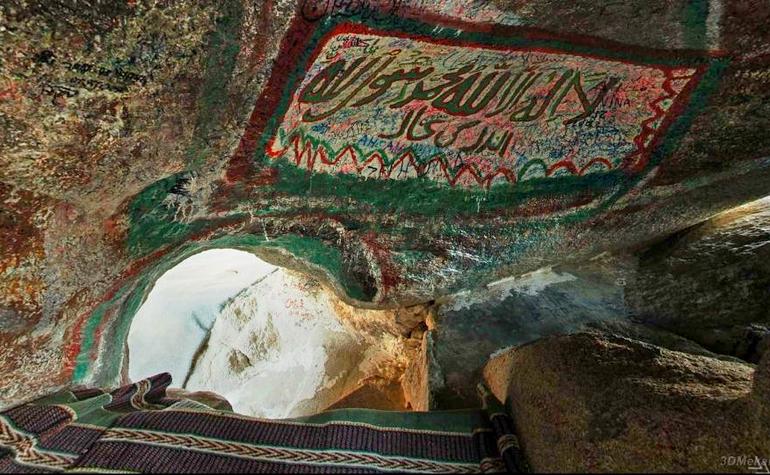The mountain of Thawr (or Jabal Thawr) is the mountain in which the cave is located, in which the Prophet (saw) and Abu Bakr (may Allah be pleased with him) sought refuge for three days and nights from Quraysh when they left Mecca and emigrated to Madinah
When the Prophet (saw) and Abu Bakr (may Allah be pleased with him) arrived at the cave on the mountain of Thawr, Abu Bakr (may Allah be pleased with him) entered first to remove everything that could harm the Prophet (saw). He found several holes and filled them with pieces of cloth. Then the Prophet (saw) entered and fell asleep on Abu Bakr’s lap (may Allah be pleased with him). Suddenly, something stung Abu Bakr’s leg (may Allah be pleased with him), but he did not twitch, fearing that he would wake the Prophet (saw). The pain was so painful that tears ran down from his cheeks and onto the face of the Prophet (saw). The Prophet (saw) woke up and saw that Abu Bakr (may Allah be pleased with him) was hurt. He applied his spittle on the wound and the pain disappeared.
 For three nights in a row, the Prophet (saw) and Abu Bakr (may Allah be pleased with him) remained hidden in a cave. During this period, the son of Abu Bakr (may Allah be pleased with him), Abdullah, spent his nights nearby. The young man was returning to Mecca very early in the morning, so the Quraysh did not know that he was sleeping elsewhere. Every day in Mecca, he collected information about the activities of Quraysh and returned every night to the mountain of Thawr, to inform the Prophet (saw) and his father Abu Bakr (may Allah be pleased with him).
For three nights in a row, the Prophet (saw) and Abu Bakr (may Allah be pleased with him) remained hidden in a cave. During this period, the son of Abu Bakr (may Allah be pleased with him), Abdullah, spent his nights nearby. The young man was returning to Mecca very early in the morning, so the Quraysh did not know that he was sleeping elsewhere. Every day in Mecca, he collected information about the activities of Quraysh and returned every night to the mountain of Thawr, to inform the Prophet (saw) and his father Abu Bakr (may Allah be pleased with him).
The slave of Abu Bakr (may Allah be pleased with him), Amir bin Fuhayrah (may Allah be pleased with him), feed the goats of Abu Bakr (may Allah be pleased with him) near the cave so that they can drink fresh milk. Early the next morning, Amir will take the goats back to Mecca along the same route as the son of Abu Bakr (may Allah be pleased with him) to obscure his footprints.
When they were inside the cave, Allah sent a spider to weave a web from a bush through the cave entrance. Allah also commanded two pigeons to fly between the spider and a tree, make a nest and lay eggs. Meanwhile, a search group of Quraysh searched the area south of Mecca, where the Prophet (saw) and Abu Bakr (may Allah be pleased with him), where they hid. They stumbled upon the mouth of the cave, and if they looked down, while they standing at the edge of the cave, they probably would have found Prophet (saw) and Abu Bakr (may Allah be pleased with him) they were hunting.
With the approach of Quraysh to discover of their hiding place, Abu Bakr (may Allah be pleased with him) became very tense because of the safety of the Prophet (saw). The Prophet (saw) assured him: “How can you be fear about two with whom is a third, especially when the third is Allah?”
On seeing the pigeon’s web and spider nest, Quraysh concluded that no one could enter the cave and leave. Describing this scene, the Quran mentions in Surah Taubah: “If you don’t help (your leader) (it doesn’t matter), because Allah really helped him when non-believers expelled him: he had no more than one companion; They were two in a cave, and he said to his companion: “Do not be afraid, for Allah is with us”: then Allah sent His peace to Him and strengthened it with forces that you had not seen, and humbled to the depths of the word of unbelievers. But the word of Allah is exalted to the heights, for Allah is exalted in power, the Wise. ” [Quran – 9:40]

READ MORE: The Most Kind Of Love From Sahaba Of The Prophet
Three days later, when they learned that the search of Quraysh had ceased, they left the cave and headed towards Yatrib (Medina). Asma (may Allah be pleased with her), the daughter of Abu Bakr (may Allah be pleased with him), came to them with food for the journey. When they were about to start, she could not find anything to tie it to their saddles, and so she unbuttoned her belt, tore it to two, put on half and tied the food to the other half. This ready solution received her praise from the Prophet (saw), who also called her “She of the two waistband.” And after that the Muslims recognized her by this name.

Sources: When the Moon Split – Shaikh Safiur-Rahman Mubarakpuri, The Life of Muhammad (ﷺ) – Tahia Al-Ismail



![[PHOTOS] Hijrah 1447: Sacred Ceremony of Kaabah’s New Cover Unfolds in Mecca [PHOTOS] Hijrah 1447 - Sacred Ceremony of Kaabah’s New Cover Unfolds in Mecca](https://islamreligionguardian.com/storage/2025/06/PHOTOS-Hijrah-1447-Sacred-Ceremony-of-Kaabahs-New-Cover-Unfolds-in-Mecca-2-218x150.jpg)

